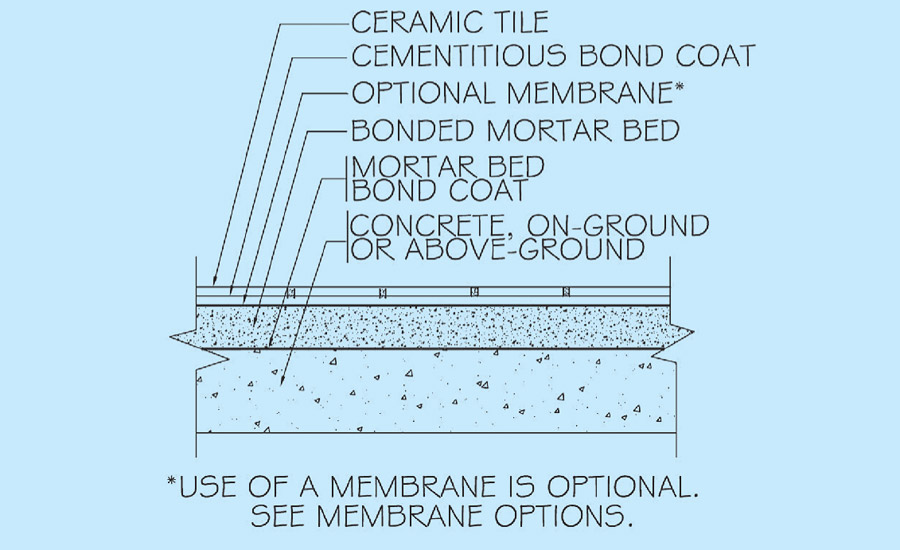Installation Insight: Tile Installations Done by the Book

Properly installed tile makes for long-lasting installations.
Photo courtesy Refin Ceramiche.

ANSI standards for tile and installation products (table courtesy of Tile Council of North America)






Properly installed ceramic tile can be a beautiful and durable floor covering for the highest traffic areas around. Malls, airports, car dealerships, exterior areas, living areas, hotels, commercial kitchens, and restaurants routinely turn to tile for a long-lasting, low maintenance solution. The challenge is to make sure the tile is “properly installed.” Luckily, the tile industry has done an excellent job putting together product and installation standards and methods. By understanding how the standards and methods can be referenced in specifications, contracts and project drawings, building owners can bring properly installed along for the ride without being an expert on tile installation. Yes, there is a right way (or more accurately, several right ways) to install tile!
In a very general sense, tile installations start with a mortar, the tile itself, a grout, and a flexible sealant. Each of these items is covered by one or more ANSI standards. Which mortar and grout to use is dependent on variables such as the substrate to be covered, the size and thickness of the tile, and the service environment of the finished installation (wet, high traffic, freeze/thaw, submerged, chemical resistance, etc). The tile is dependent on factors such as if the installation will be walked upon when wet, the point loads to which it will be subjected, freeze/thaw considerations, and aesthetic considerations. Flexible sealants are used for movement joints to allow for expansion and contraction of the tile and at changes of plane.
Often, a membrane is also included in the system. Membranes can keep cracks from below from coming up through the tile, keep sound from transmitting through the system, waterproof in wet areas (tile and grout themselves aren’t considered waterproof) and reduce the overall height required for the installation. Again, membranes are typically covered by one or more ANSI specifications. By including the ANSI designation for the products selected in the project documents and specifications, a building owner can mandate a minimum performance level and make sure competitive bids can be directly compared:
Once the products have been selected and specified, it’s time to detail how the products should be applied. Again, ANSI has standards for the proper installation of a variety of situations. Referencing these installation standards also pulls in language about who does what (the responsibilities of other trades) and substrate flatness requirements. Even if you don’t know that a 15” or larger tile should only be set on substrates with 1/8” of elevation difference in 10’, ANSI knows and by referencing A108.02 in your project documents, that information is included in the standard.
Bi-annual meetings are held to refine the ANSI standards for products and installations. Because these are standards recognized by the government, the committee must keep a balance between manufacturers (including MAPEI), consultants, and ‘end users’ so no one group of interests can predominate.
While other flooring products have standards, the tile industry sets itself apart with the methods published by the Tile Council of North America (TCNA) in their annual Handbook for Ceramic, Glass, and Stone Tile Installation. These methods show how a properly constructed system of products should go together. They are also the basis for most tile specifications in circulation today. As with ANSI, a committee of installers, manufacturers (including MAPEI), consultants, and others with an interest in the Handbook meets yearly to review the existing methods and circulate new methods that may be missing based on the latest products, methods, and applications. An example of a basic TCNA method is F112-18:
Tile installation ... involves knowing what is below the tile and what the installation will be exposed to once it is in place.
This method represents a fairly basic installation of floor tile over a mortar bed. Other methods address showers and bath, exterior installation, walls, different substrates, even ceilings and countertops. By specifying the proper method, the proper tile and installation products come along for the ride. The handbook has 50 pages devoted to definitions and best practices, including an entire section on how to use the methods in specifications, followed by over 200 methods.
Tile installation is about more than mixing mortar and floating grout. It involves knowing what is below the tile and what the installation will be exposed to once it is in place. The same tile can be installed in a steam shower and on a backsplash, but if the same materials are used, the steam shower won’t last. The tile industry wants to promote successful tile installations and has done a great job of standardizing the products, methods, and processes involved. By spending a few hours learning to understand the Handbook for Ceramic, Glass, and Stone Tile Installation, everyone dealing with tile installations will know how it should be done – by the book.
Looking for a reprint of this article?
From high-res PDFs to custom plaques, order your copy today!










